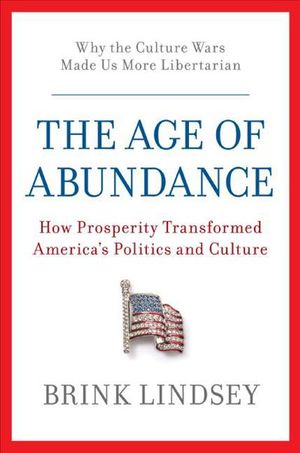The Age of Abundance
Published by HarperCollins
How America’s post-WWII affluence led to today’s divide between red states and blue states: “[Lindsey’s] insights are frequently dazzling.” —Los Angeles Times
Until the 1950s, the struggle to feed, clothe, and employ the nation drove most of American politics. From slavery to the New Deal, political parties organized around economic interests and engaged in fervent debate over the best allocation of agonizingly scarce resources. But with the explosion of the nation’s economy in the years after World War II, a new set of needs began to emerge—a search for meaning and self-expression on one side, and a quest for stability and a return to traditional values on the other.
In The Age of Abundance, Brink Lindsey offers a bold reinterpretation of the latter half of the twentieth century. In this sweeping history of postwar America, the tumult of racial and gender politics, the rise of the counterculture, and the conservative revolution of the 1980s and 1990s are portrayed in an entirely new light. Readers will learn how and why the contemporary ideologies of left and right emerged in response to the novel challenges of mass prosperity.
The political ideas that created the culture wars, however, have now grown obsolete. Struggling to replace today’s stale conflicts is a new consensus that mixes the social freedom of the left with the economic freedom of the right into a potentially powerful ethos of libertarianism. The Age of Abundance is “a wise, revealing book combining the long sweep of history with a documentarian’s eye for detail” (Dallas Morning News).
“Breathtaking analysis . . . pinpoints the current tensions between the political Left and Right to a 1967 San Francisco love-in and the opening of Oral Roberts University, both ‘eruptions of millenarian enthusiasm.’” —Booklist (starred review)
“Scintillating.” —The New York Times Book Review
“Provocative analysis . . . A thoughtful attempt to explain—and claim—the broad center in the middle of our political squabbling.” —Kirkus Reviews
Until the 1950s, the struggle to feed, clothe, and employ the nation drove most of American politics. From slavery to the New Deal, political parties organized around economic interests and engaged in fervent debate over the best allocation of agonizingly scarce resources. But with the explosion of the nation’s economy in the years after World War II, a new set of needs began to emerge—a search for meaning and self-expression on one side, and a quest for stability and a return to traditional values on the other.
In The Age of Abundance, Brink Lindsey offers a bold reinterpretation of the latter half of the twentieth century. In this sweeping history of postwar America, the tumult of racial and gender politics, the rise of the counterculture, and the conservative revolution of the 1980s and 1990s are portrayed in an entirely new light. Readers will learn how and why the contemporary ideologies of left and right emerged in response to the novel challenges of mass prosperity.
The political ideas that created the culture wars, however, have now grown obsolete. Struggling to replace today’s stale conflicts is a new consensus that mixes the social freedom of the left with the economic freedom of the right into a potentially powerful ethos of libertarianism. The Age of Abundance is “a wise, revealing book combining the long sweep of history with a documentarian’s eye for detail” (Dallas Morning News).
“Breathtaking analysis . . . pinpoints the current tensions between the political Left and Right to a 1967 San Francisco love-in and the opening of Oral Roberts University, both ‘eruptions of millenarian enthusiasm.’” —Booklist (starred review)
“Scintillating.” —The New York Times Book Review
“Provocative analysis . . . A thoughtful attempt to explain—and claim—the broad center in the middle of our political squabbling.” —Kirkus Reviews
BUY NOW FROM
COMMUNITY REVIEWS

